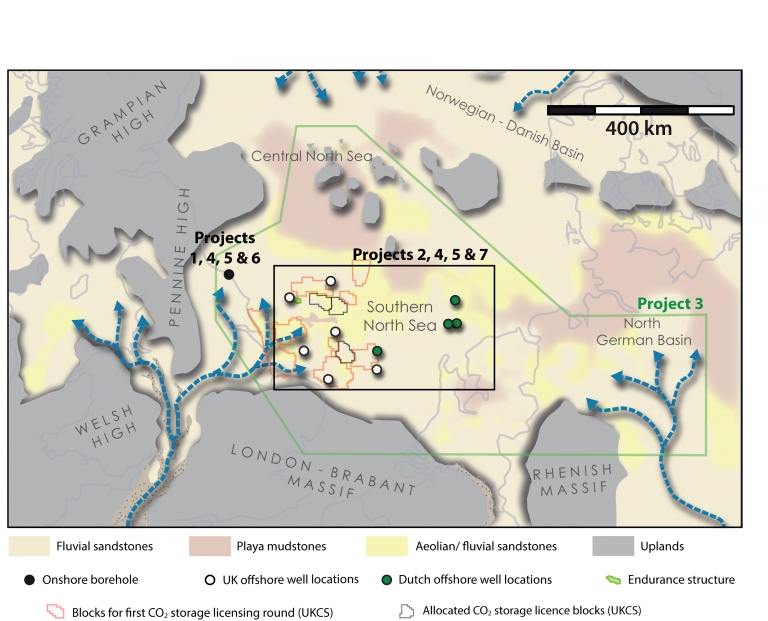Bunter Sandstone Storage Complex Thematic Research
The Lower to Middle Triassic Bunter Sandstone Formation represents the primary CO2 storage reservoir in the Southern North Sea and will play an integral role in the UK’s Net Zero Strategy. It is the main interval of interest for the Endurance structure (UK Blocks 42/25 and 43/21; Figure 1), one of two CO2 storage sites selected by the UK Government for initial development, and is central to the North Sea Transition Authority’s first carbon storage licensing round. A thorough understanding of the Bunter Sandstone storage complex’s composition, correlation and timing of deposition, as well as how the reservoir and seal will behave when subjected to the injection of CO2 is essential.

The first phase of projects (see below) within this research theme will be based on a newly available cored section from an onshore borehole in North Yorkshire, as well as core and cuttings from selected wells of the Southern North Sea (UK and Dutch sectors). A palynostratigraphy and cyclostratigraphy will be established that will enable the correlation of strata across the basin and provide a framework for compositional and provenance studies, as well as an assessment of regional seal units.
Together these projects will better inform the assessment of Lower to Middle Triassic strata in the Southern North Sea for CO2 storage. Futher research is anticipated to model the impact of composition variability on CO2 reactivity and reservoir efficiency, as well as modelling of seal performance in the Bacton and Haisborough groups, using the data generated by these projects.
- A Palynozonation of the Bunter Sandstone CO2 storage complex: onshore analogue study (CASP.BSSC.1)
- Palynostratigraphy of the Bunter Sandstone CO2 storage complex in the Southern North Sea (CASP.BSSC.2)
- Cyclostratigraphy of the Early to Middle Triassic of the Southern North Sea (CASP.BSSC.3)
- Reservoir composition and diagenesis (CASP.BSSC.4)
- Controls on Bunter Sandstone composition (CASP.BSSC.5)
- Middle Triassic seals – onshore analogue study (CASP.BSSC.6)
- Middle Triassic seals – UK and Dutch offshore wells study (CASP.BSSC.7)
Contact(s): Mike Curtis
Reports Issued in This Theme
Products
- Thematic Research
- Mudrock Seals in CO2 Storage Systems Thematic Research
- Bunter Sandstone Storage Complex Thematic Research
- A palynozonation of the Bunter Sandstone CO2 storage complex: onshore analogue study (CASP.BSSC.1)
- Palynostratigraphy of the Bunter Sandstone CO2 storage complex in the Southern North Sea (CASP.BSSC.2)
- Cyclostratigraphy of the Early to Middle Triassic of the Southern North Sea (CASP.BSSC.3)
- Reservoir composition and diagenesis (CASP.BSSC.4)
- Controls on Bunter Sandstone composition (CASP.BSSC.5)
- Middle Triassic seals – onshore analogue study (CASP.BSSC.6)
- Middle Triassic seals – UK and Dutch offshore wells study (CASP.BSSC.7)
- Reactions and Flow of CO2 Fluid in Compositionally Immature Sandstones Thematic Research
- The Impact of Volcaniclastic Rocks on CO2 Storage Thematic Research
- Non-thematic Research
- Reports
- Data Packages
- Geological Collections and Data
